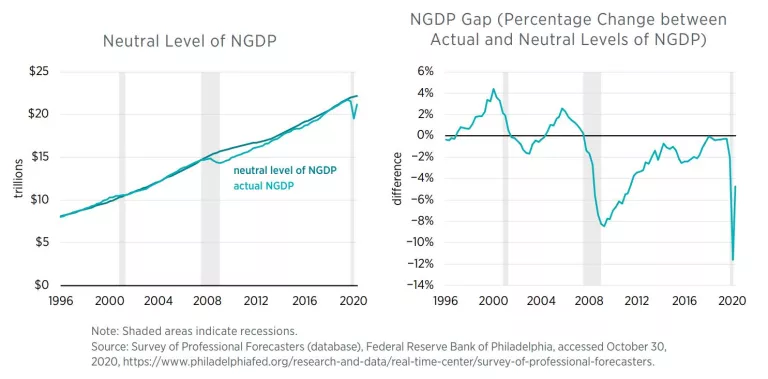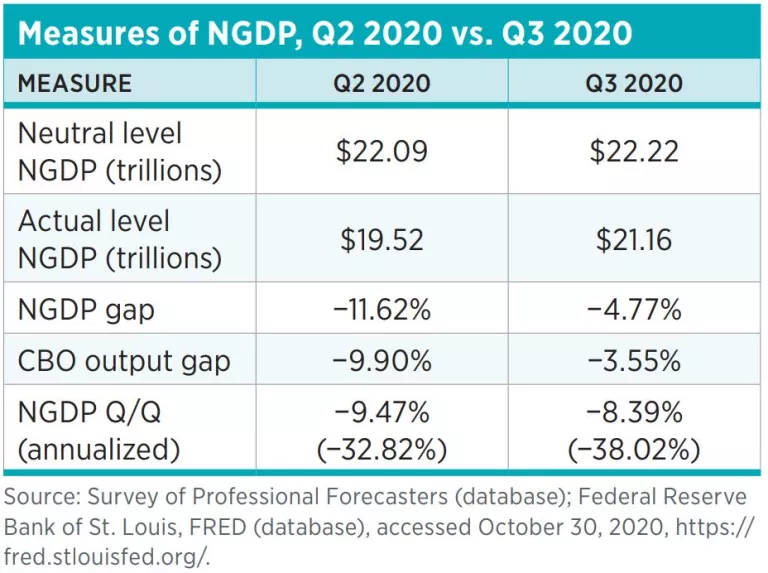- | Monetary Policy Monetary Policy
- | Policy Briefs Policy Briefs
- |
The Neutral Level of NGDP and the NGDP Gap: Q3 2020

The nominal GDP (NGDP) gap, a measure of unexpected changes in the dollar size of the US economy, is the percentage difference between the actual and the neutral level of NGDP. The neutral level of NGDP, in turn, is a sum of all dollar incomes expected by households and businesses coming into a specific time period. In the third quarter of 2020, the NGDP gap was −4.77 percent, a significant narrowing from the −11.62 percent NGDP gap experienced in the second quarter of 2020 (see figures above).

Despite this progress, an NGDP gap of −4.77 percent indicates that the dollar size of the economy is still significantly smaller than prepandemic expectations. Specifically, the neutral level of NGDP was $22.22 trillion in the third quarter of 2020, whereas actual NGDP came in at $21.16 trillion. That is a shortfall of $1.06 trillion, which is a vast improvement over the previous quarter’s shortfall of $2.57 trillion, but still a sizable hole to fill in the economy. This trillion-dollar hole means that both aggregate spending and income are still falling short of their prepandemic trend levels.
By way of comparison, the Congressional Budget Office (CBO) output gap reveals that the real economy was 3.55 percent smaller than its true potential over the same period. Relative to the previous quarter, actual NGDP grew by 8.39 percent (38.02 percent on annualized basis). This NGDP growth was the highest on record but still not sufficient to close the negative NGDP gap.
A Closer Look at the NGDP Gap
As noted, the NGDP gap requires an estimate of the neutral level of NGDP. The neutral level of NGDP is estimated by taking an average forecast of NGDP, or equivalent total nominal income, for a given quarter on the basis of forecasts for that period from the preceding 20 quarters. The forecast data used here are taken from the Federal Reserve Bank of Philadelphia’s Survey of Professional Forecasters.
The NDGP gap measures the percentage difference between this average forecast and the actual level of NGDP. If the actual level of NGDP is less than the neutral level, then macroeconomic policy is contractionary. If actual NGDP is greater than the neutral level, then macroeconomic policy is expansionary.
The rationale for this understanding is twofold. First, members of the public make many economic decisions, such as whether to take out a mortgage or a car loan, on the basis of forecasts of their nominal income. Similarly, firms may finance with debt and commit to multiyear contracts on plants, raw materials, and labor on the basis of forecasts of their nominal income. Second, the actual realization of nominal incomes may turn out to be very different from what is expected and, as a result, may be disruptive for households and firms that are not able to quickly adjust their economic plans. These disruptions can be avoided by maintaining total nominal income or NGDP on the growth path expected by the public. In other words, the Federal Reserve should aim to close the NGDP gap in order to keep monetary conditions neutral.
For more information on how the NGDP gap is constructed and how it may be used to understand policy, please see “The Stance of Monetary Policy: The NGDP Gap,” a policy brief by David Beckworth. Also, see the NGDP gap web page hosted by the Mercatus Center that provides access to current and vintage data on the NGDP gap.
Key Materials
Download the Publication PDF.
Contact Us
To speak with a scholar or learn more on this topic, visit our contact page.

